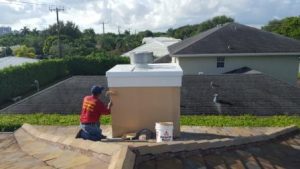 Keeping your chimney clean and well maintained not only extends its life but also keeps your home warm and clean. Sweeping your chimney is an essential part of taking care. A well-cleaned chimney lowers the risk of fires that can occur due to the build-up called creosote. When you burn wood, what is left behind in the chimney is the Creosote resin, which is flammable and should be cleaned out regularly. If you observe that the wood is not burning at all or burning slowly, these are signs that the cement needs to be cleaned. Routine cleaning can prevent the creosote to build up dangerous levels.
Keeping your chimney clean and well maintained not only extends its life but also keeps your home warm and clean. Sweeping your chimney is an essential part of taking care. A well-cleaned chimney lowers the risk of fires that can occur due to the build-up called creosote. When you burn wood, what is left behind in the chimney is the Creosote resin, which is flammable and should be cleaned out regularly. If you observe that the wood is not burning at all or burning slowly, these are signs that the cement needs to be cleaned. Routine cleaning can prevent the creosote to build up dangerous levels.
How does creosote develop?
The problem with creosote is that once it forms, it causes the wood to burn incompletely. The smoky fire does not carry enough oxygen. This causes lots of tar vapors that can get condensed inside the flue and stick to it, and thus cause the formation of creosote. A creosote buildup can lead to a chimney fire. One way of reducing the creosote is providing sufficient combustion air that can encourage a clean-burning fire.
Equipment for cleaning
Make sure you have the chimney cleaning supplies such as chimney brush, extension pipes, smaller stiff wire brush, drop cloth and a ladder tall enough to reach your roof. Cover your hair with a cloth or bandanna and wear old clothes as the job is going to be messy. Wear gloves to shield your hands and a dust mask and goggles to protect your face and eyes.
Before cleaning the chimney, one needs to check the thickness of the creosote. There should be no downdraft stops or reverses or any air flows up. Wear a basic dust mask and goggles and do not forget to take a strong flashlight. Scratch the black surface above the damper with your fireplace poker. If the coating is paper thin, there is no need to clean the chimney. However, if the coating is 1/8 in thick or more, it means that the chimney requires cleaning. Avoid using the fireplace if the creosote is slightly thick as there are risks of a chimney fire.
Flash your light inside the smoke chamber and around the damper to check for creosote and the flue, which builds on the exterior chimneys. Because of the lower temperatures outside, the creosote builds faster here as compared to the interior of the chimney. The feather-light dull gray, brown or black creosote is the easiest to remove. The toughest is the road tar–like coating or the shiny, glaze-like coating that seems virtually impossible to remove.
Boca Raton chimney repair company
If you are confident of removing the creosote yourself, make sure that you do a thorough job. As the cleaning and sweeping the chimney is very messy, it is advisable to get the task done by a professional. Call a professional chimney cleaner who is certified to do the job. Cleaning the chime means not just removing the cleaning out creosote, but removing other debris. Get your chimney inspected latest twice a year for any signs of deterioration or venting problems. You can call boca raton chimney repair company to solve your problem
